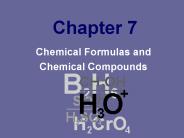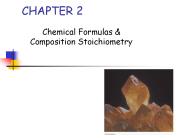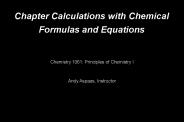Chemical Formula PowerPoint PPT Presentations
All Time
Recommended
Objectives:Describe how chemical reactions produce new substances with different properties. Identify four signs that a chemical reaction might be taking place.
| PowerPoint PPT presentation | free to view
Chemical Formulas and Chemical Compounds Chapter 7 Chemical Formulas Octane Molecule C8H18 Aluminum Sulfate formula unit Al2(SO4)3 Monatomic Ions Def: ions formed ...
| PowerPoint PPT presentation | free to view
Modern Chemistry Chapter 7 Chemical Formulas and Chemical Compounds Sections 1, 3 & 4 Chemical Names and Formulas Using Chemical Formulas Determining Chemical Formulas
| PowerPoint PPT presentation | free to view
Chemical Formulas and Chemical Compounds Chapter 7 What Do You Think? CCl4 MgCl2 Guess the name of each of the above compounds based on the formulas written.
| PowerPoint PPT presentation | free to view
Chemical Formulas and Chemical Compounds Chapter 7 Oxidation Numbers Assigning Oxidation Numbers In general: shared electrons are assumed to belong to the more ...
| PowerPoint PPT presentation | free to download
Chemical Formulae, Types of Reactions, Chemical Equations, and Balancing
| PowerPoint PPT presentation | free to view
Chemical Formulae, Types of Reactions, Chemical Equations, and Balancing Chemical Formulae Indicates the # of atoms of each type in a molecule or the ratio of the ...
| PowerPoint PPT presentation | free to view
Chapter 3. Stoichiometry: Calculations with Chemical Formulas and Chemical Equations. What is Stoichiometry. Quantitative nature of chemical formulas and chemical ...
| PowerPoint PPT presentation | free to view
Chemical Equations, and Balancing. Chemical Formulae ... Balancing Chemical Equations! Balanced chemical equations tells you the ratio in which the ...
| PowerPoint PPT presentation | free to view
Burning is a chemical change. When a substance undergoes a chemical change, a chemical reaction is said to take place. What is the law of conservation of mass?
| PowerPoint PPT presentation | free to view
Chemical Formulas Writing Binary Compounds Tim Bass Chemical Formulas A shorthand method of representing the makeup of chemicals using chemical symbols and oxidation ...
| PowerPoint PPT presentation | free to download
Chemical Formulas Chapter 7 Chemical Nomenclature Ionic Compounds often a metal + nonmetal anion (nonmetal), add ide to element name Transition metal ionic ...
| PowerPoint PPT presentation | free to view
Topic: Chemical Formulas Subscripts in Chemical Formulas Chemical Formulas H2O has: 2 hydrogens and 1 oxygen NH3 has: 1 nitrogen and 3 hydrogens CH4 has ?
| PowerPoint PPT presentation | free to download
Chapter 7 Chemical Formulas and Chemical Compounds Section 1: Chemical Names & Formulas There are literally thousands of chemicals Isn t always best to use common ...
| PowerPoint PPT presentation | free to download
Writing Chemical Formulas Metals vs Nonmetals Metals Nonmetals Lose electrons (e-) Form Cations (+ ions) Gain electrons (e-) Form Anions ( - ions) Attracted to ...
| PowerPoint PPT presentation | free to view
C2H4O2 60.05 Acetic acid Acetate polymers; vinegar ( 5% solution) ... Determining a Chemical Formula from. Combustion Analysis - I ...
| PowerPoint PPT presentation | free to view
Chemical Formulas & Chemical Compounds Chapter 7
| PowerPoint PPT presentation | free to download
DETERMINING CHEMICAL FORMULAS What if you discovered the cure for cancer? Any new chemical that is discovered that is a potential health care treatment must have its ...
| PowerPoint PPT presentation | free to view
Chemical Names and Formulas
| PowerPoint PPT presentation | free to download
Title: Chemical Bonding Author: Chemistry Created Date: 10/3/2002 11:58:47 AM Document presentation format: On-screen Show (4:3) Manager: Paul Hampton
| PowerPoint PPT presentation | free to download
Chemical Composition Chemical Quantities Chapters 9&10 Pg. 221-293 Chemical Composition Atomic Masses- Because the mass of one atom is so small- on the order of 10-23 ...
| PowerPoint PPT presentation | free to view
Chemical Formulas & Composition ... Know how to write chemical formulas ... smallest particle of a substance carrying its physical and chemical properties ...
| PowerPoint PPT presentation | free to download
Chemical Formulas. 1. The formula that indicates the total number of atoms of the elements in a ... 3. The formula mass of limewater Ca(OH)2, when Ca = 40.1, O ...
| PowerPoint PPT presentation | free to view
Chemical Formulas and the Mole Introduction 84 potatoes 63 carrots 15 onions 3 heads of garlic 27 turnips 42 pieces of celery 9 cans of green beans 6 cans of tomato ...
| PowerPoint PPT presentation | free to download
Chemical Equations Balancing, Types of Equations Compound Composition Atom mass; Atomic and formula weight % Composition Empirical Formulas Mole Amounts; Molar Mass ...
| PowerPoint PPT presentation | free to view
Section 1 Chemical Names and Formulas. Section 2 Oxidation Numbers ... Cupric oxide. CuO. Cu2O. Naming Monatomic Ions. x-ide. Writing and Naming Binary Ionic Compounds ...
| PowerPoint PPT presentation | free to view
A chemical formula is a shorthand notation for a compound or a diatomic element ... 11. Calcium monobromide- CaBr. antimony tribromide SbBr3. hexaboron silicide B6Si ...
| PowerPoint PPT presentation | free to view
Chapter 3 Stoichiometry: Calculations with Chemical Formulas and Equations
| PowerPoint PPT presentation | free to download
Chemical Equations and Chemical Reactions Step 1: Write in the symbols for all atoms and ions (skeleton equation) Balance each compound Remember diatomic ions: H2, N2 ...
| PowerPoint PPT presentation | free to view
CHEMISTRY The Central Science 9th Edition Chapter 3 Stoichiometry: Calculations with Chemical Formulas and Equations
| PowerPoint PPT presentation | free to download
Chemistry, The Central Science, 10th edition Theodore L. Brown, H. Eugene LeMay, Jr., and Bruce E. Bursten Chapter 3 Stoichiometry: Calculations with Chemical ...
| PowerPoint PPT presentation | free to view
Percent Composition From a Chemical Formula Chemistry 11 Ms. McGrath Percentage Composition From a Chemical Formula Percentage composition Refers to the relative mass ...
| PowerPoint PPT presentation | free to view
Cpt 7 Chemical formulas Guided Reading, pages 164-170 What is a chemical symbol? Why do they use them? What is the format for a chemical symbol?
| PowerPoint PPT presentation | free to download
FINDING EMPIRICAL AND CHEMICAL FORMULAS BY EXPERIMENT Chemistry 11 Ms. McGrath Finding Empirical and Chemical Formulas by Experiment We know how to find percentage ...
| PowerPoint PPT presentation | free to view
3 Chemical Equations and Stoichiometry 3.1 Formulae of Compounds 3.2 Derivation of Empirical Formulae 3.3 Derivation of Molecular Formulae 3.4 Chemical Equations
| PowerPoint PPT presentation | free to view
Chapter 9 Chemical Names and Formulas 9.1 Naming Ions 9.2 Naming and Writing Formulas for Ionic Compounds 9.3 Naming and Writing Formulas for Molecular Compounds
| PowerPoint PPT presentation | free to view
Chapter 10. Chemical Calculations II Chemical Reactions Stoichiometry is the calculation of the quantities of reactants and products in a chemical reaction.
| PowerPoint PPT presentation | free to download
Title: Chapter 2: Chemical Reactions Section 1: Observing Chemical Change How can matter and changes in matter be described? Author: Owner Last modified by
| PowerPoint PPT presentation | free to view
Chemistry, The Central Science, 10th edition Theodore L. Brown, H. Eugene LeMay, Jr., and Bruce E. Bursten Chapter 3 Stoichiometry: Calculations with Chemical ...
| PowerPoint PPT presentation | free to view
Chemical Formulas represent compounds. Oxidation Numbers are used to determine the ratio in which elements combine to form compounds. Chemical formulas are composed ...
| PowerPoint PPT presentation | free to view
Chemical formula molar ratio of atoms. Chemical equations molar ratio ... When 0.750 g iron(III) chloride hydrate is heated, 0.300 g of steam is produced. ...
| PowerPoint PPT presentation | free to view
Chapter 9 Review Chemical Names and Formulas Pre-AP Chemistry Charles Page High School Stephen L. Cotton Chapter 9 Review In which of the following are the ...
| PowerPoint PPT presentation | free to download
Stoichiometry. Law of Conservation of Mass ' ... Stoichiometry. Anatomy of a Chemical Equation ... Stoichiometry ...
| PowerPoint PPT presentation | free to view
Get a sample brochure @ http://tinyurl.com/jf848gd Phosphorus Chloride or PCl3 is important chemical that is used in many chemical industries as a feedstock to produce phosphorus pentachloride and other important chemicals that are used in various end user companies in the production of fertilizers, insecticides, additives and others. The Phosphorus Trichloride Market has high scope in the industrial activities and is expected to have high demand in various regions in the upcoming term.
| PowerPoint PPT presentation | free to download
CHAPTER 4 CHEMICAL REACTIONS: MAKING CHEMICALS SAFELY WITHOUT DAMAGING THE ENVIRONMENT From Green Chemistry and the Ten Commandments of Sustainability, Stanley E ...
| PowerPoint PPT presentation | free to download
One mole of molecules or formula units contains Avogadro's ... The coefficients in the balanced equation give the ratio of moles of reactants and products ...
| PowerPoint PPT presentation | free to view
Avogadro's number (NA): The number of particles in exactly one mole of a pure substance. ... 3. CuSO4 * 5H2O [% water in the hydrate] Determining Chemical ...
| PowerPoint PPT presentation | free to view
Molar mass: mass of 1 mole of a substance. Equal to formula weight of that substance! ... Mass % from formula: Assume you have 1 mol of the substance, what mass ...
| PowerPoint PPT presentation | free to download
Calculations with Chemical Formulas and Equations Law of Conservation of Mass We may lay it down as an incontestable axiom that, in all the operations of art and ...
| PowerPoint PPT presentation | free to view
Chemical reactions: involve largely the outer (valence) electrons of an atom ... (the reaction that occurs in an air bag in a motor car) metal azide metal nitrogen ...
| PowerPoint PPT presentation | free to view
One mole of molecules or formula units contains Avogadro's number times the ... From the mass of Substance A you can use the ratio of the coefficients of A and ...
| PowerPoint PPT presentation | free to view
One mole of molecules or formula units contains Avogadro's number times the ... One can calculate the empirical formula from the percent composition. Stoichiometry ...
| PowerPoint PPT presentation | free to view
Chemistry, The Central Science, 10th edition ... So, the formula weight of calcium chloride, CaCl2, would be. Ca: 1(40.1 amu) Cl: 2(35.5 amu) ...
| PowerPoint PPT presentation | free to view
In this chapter, chemical changes will be used to explore the quantity of ... Converting moles to mass. Calculate the number of moles of glucose C6H12O6 in 5. ...
| PowerPoint PPT presentation | free to view
Solutions, Acids and Bases, Thermodynamics, Electrochemistry, Precipitation, Chemical Equilibrium, and Chemical Kinetics By: Karl Lewis, Mark Liv, Kevin Mahon, Doug Reed
| PowerPoint PPT presentation | free to view
Module 3: Chemical Formulas and Composition Stoichiometry Part 2. By: Alyssa Jean-Mary ... The empirical (simplest) formula of a compound is the smallest ...
| PowerPoint PPT presentation | free to view
























































